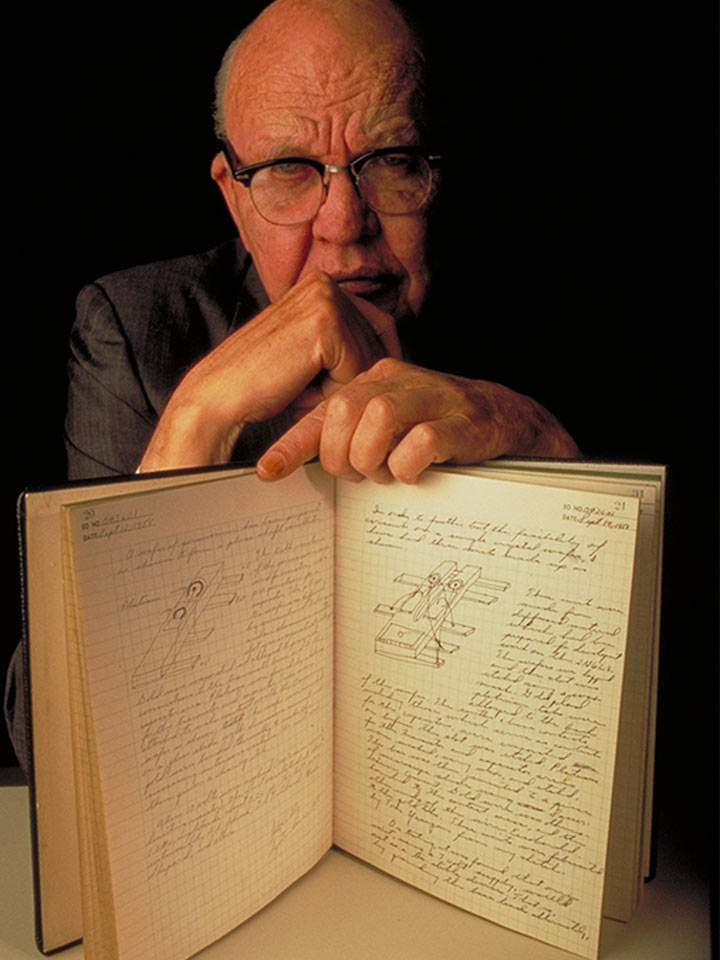
In 1958, as one of the few employees working through summer vacation at our company, electrical engineer Jack Kilby had the lab to himself. And it was during those two solitary weeks that he hit upon an insight that would transform the electronics industry.
Since 1948, transistors had begun to replace large, power-hungry vacuum tubes in electronics manufacturing, but hand-soldering thousands of these individual components onto a chip was expensive, time-consuming and unreliable.
Jack’s insight was that the same semiconductor materials used to make transistors could be tweaked to produce resistors and capacitors, too. This meant an entire circuit could be produced from a single slice of semiconductor material.
Later that year, on Sept. 12, Kilby presented his invention: An electronic oscillator formed from a small slice of the semiconductor material germanium. The first integrated circuit was born, bringing with it the exponential growth of the electronics industry and the spread of electronic devices throughout every aspect of our lives.

| Learn how Jack Kilby’s integrated circuit and our people helped land man on the moon 50 years ago. |

Unleashing creativity in electronics
Our company needed a showcase device, something that could prove the integrated circuit's potential to take large, unwieldy and expensive technology out of specialized computing labs and into the wider public's offices, homes and pockets. They settled on a hand-held calculator. At the time, a calculator was a large desktop machine that required a constant AC power supply. When our prototype was unveiled in 1967, it used just four integrated circuits to perform addition, subtraction, multiplication and division. It weighed 45 ounces and could fit in the palm of your hand.
At the time, a calculator was a large desktop machine that required a constant AC power supply. When our prototype was unveiled in 1967, it used just four integrated circuits to perform addition, subtraction, multiplication and division. It weighed 45 ounces and could fit in the palm of your hand.
Chip complexity began to grow exponentially, now that the creative energy of electronics engineers was finally unleashed from the constraints of wiring together individual transistors. The most significant result was the creation of the first microprocessor, which packed the workings of an entire central processing unit into less than a square inch – and supported the development of the first portable computers.
Circuits in space
The miniaturization of electronics came in handy for coordination of the first moon mission, since the idea of launching the car-sized mainframes used by NASA's ground control up on a rocket itself was both physically and economically impossible.
Instead, the space agency created the world's first integrated circuit-based spaceflight control system, the Apollo Guidance Computer. In July 1969, running around 145,000 lines of code with 12,300 transistors, this 70-pound computer successfully coordinated both Neil Armstrong and Buzz Aldrin's arrival on the moon – and their safe return to Earth eight days later.
Ubiquitous Computation
Chips many thousands of times more powerful than those used in the Apollo Guidance system can now be found everywhere from factory robots to car dashboards, cell phones, computers, smart watches and smart speakers. They can even be found inside the ears of millions of people around the world in the form of hearing aids.
Forty-two years after that pivotal couple of weeks in 1958, Jack accepted half of the Nobel Prize in physics for his invention. In his acceptance speech, he reflected on the host of electronics innovations that have been developed since – far beyond what he’d imagined possible at the time: "It's like the beaver told the rabbit as they stared at the Hoover Dam. 'No, I didn't build it myself, but it's based on an idea of mine.'"